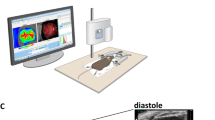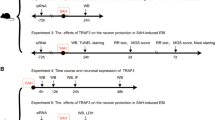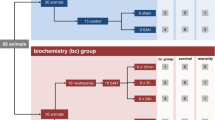Abstract
Molecular biologic investigations in the past decades have begun to unravel the intracellular mechanisms involved in vasomotor regulation of cerebral blood vessels and their failure in delayed cerebral vasospasm produced by aneurysmal subarachnoid hemorrhage. Progress in deciphering macrovascular regulatory mechanisms and their failure in delayed cerebral vasospasm induced by aneurysmal subarachnoid hemorrhage have revealed that there are at least two important vasoactive substances—nitric oxide and endothelin-1—that play important roles in the clinical manifestations of subarachnoid-hemorrhage-induced cerebral vasospasm. Nitric oxide is a cell-membrane-permeable free radical gas that accounts for the phenomenon of vasodilatation by a variety of vasodilator agents. Endothelin-1, a 21 amino acid peptide, is one of the most potent constricting factors. Cerebral vasospasm is thought to represent a disturbance in the cerebral vasomotor equilibrium for which these two physiologically antagonistic compounds are at least partly responsible. Advances in our understanding of the molecular responses of the cerebral vasculature to subarachnoid hemorrhage should lead to more comprehensive management as knowledge becomes translated into development of effective pharmacologic agents to reverse or prevent cerebral vasospasm following aneurysmal subarachnoid hemorrhage.
This is a preview of subscription content, access via your institution
Access options
Subscribe to this journal
Receive 12 print issues and online access
$209.00 per year
only $17.42 per issue
Buy this article
- Purchase on Springer Link
- Instant access to full article PDF
Prices may be subject to local taxes which are calculated during checkout



Similar content being viewed by others
Notes
Editor's statement
An article response has been published in connection with this article. Various editorial issues arose during the publication processes that warrant elucidation.
Dr Agustinus Suhardja accepted an invitation on behalf of himself and Dr Robert Furchgott to submit a review paper for Nature Clinical Practice Cardiovascular Medicine. A license to publish form was signed by Dr Suhardja, which is irrevocable, and was sent at the time of article submission.
On the day of printing, Dr Suhardja asked journal staff to remove all references to Dr Furchgott from the article since he had waited until the last minute to confirm with Dr Furchgott that he wanted to be a coauthor, and at that point Dr Furchgott declined to be named as such. The removal of Dr Furchgott’s name was arranged.
After the journal had been printed, on the day of distribution, Dr Suhardja asked for the article to be withdrawn, but it was too late to stop distribution. The reason given for the requested retraction, after questioning, was that Dr Suhardja had incorporated extensive comments from one peer-reviewer without asking permission and without discussing concerns raised by the peer-reviewer (in any way), despite being invited to do so by the referee and having been given contact information. A contribution from the referee was acknowledged in the article, but without permission. Given the knowledge of the referee’s willingness to work with the authors and the fact that no comment about a lack of communication was made by either party, the journal staff assumed that incorporation of the comments into the paper had been discussed.
To clarify on behalf of the journal, throughout the editorial process the reasons for each stage and the forms related to the publication of articles are clearly explained to authors; additional information is readily accessible on the journal’s website (http://www.nature.com/clinicalpractice). Questions can be raised at any time before proofs are finalized. The signing of all forms is binding, and must be completed before an article is accepted for publication. Any concerns about authorship and permission to cite information in the form of text or display items from any source other than the authors must be satisfactorily resolved before an article is accepted for publication. Like the readers of Nature Clinical Practice Cardiovascular Medicine, the Editorial Office relies on the honesty and integrity of authors and peer-reviewers. In this case, we acted in good faith upon information received from the author (both before and after publication), and have brought the circumstances to your attention in order to assist you with your interpretation of the article’s content. We welcome your comments on the article; please use the online system to submit them (http://mts-ncpcm.nature.com).
References
Ecker A and Riemenschneider PA (1951) Arteriographic demonstration of spasm of the intracranial arteries. J Neurosurg 8: 660–667
Allcock JM and Drake CG (1965) Ruptured intracranial aneurysms: the role of arterial spasm. J Neurosurg 22: 21–29
Weir B et al. (1978) Time course of vasospasm in man. J Neurosurg 48: 173–178
Nornes H (1973) The role of intracranial pressure in the arrest of hemorrhage in patients with ruptured intracranial aneurysm. J Neurosurg 39: 226–234
Pluta RM et al. (1997) Source and cause of endothelin-1 release into cerebrospinal fluid after subarachnoid hemorrhage. J Neurosurg 87: 287–293
Dreier JP et al. (2000) Products of hemolysis in the subarachnoid space inducing spreading ischemia in the cortex and focal necrosis in rats: a model for delayed ischemic neurological deficits after subarachnoid hemorrhage? J Neurosurg 93: 658–666
Kleeberg J et al. (2004) ET-1 induces cortical spreading depression via activation of the ETA receptor/phospholipase C pathway in vivo. Am J Physiol Heart Circ Physiol 286: H1339–H1346
Bian K and Murad F (2003) Nitric oxide (NO)—biogeneration, regulation, and relevance to human diseases. Front Biosci 8: 264–278
Buchanan JE and Phyllis JW (1993) The role of nitric oxide in the regulation of cerebral blood flow. Brain Res 610: 248–255
Pluta R et al. (1997) Temporal changes in perivascular concentrations of oxyhemoglobin, deoxyhemoglobin and methemoglobin in subarachnoid hemorrhage. J Neurosurg 88: 557–561
Foley PL et al. (1993) Hemoglobin penetration in the wall of the rabbit basilar artery after subarachnoid hemorrhage and intracisternal hemoglobin injection. Acta Neurochir 123: 82–86
Iuliano B et al. (2004) Endothelial dysfunction in a primate model of cerebral vasospasm. J Neurosurg 100: 287–294
Furchgott RF and Zawadzki JV (1980) The obligatory role of endothelial cells in the relaxation of arterial smooth muscle by acetylcholine. Nature 288: 373–376
Jung CS et al. (2004) Association between cerebrospinal fluid levels of asymmetric dimetyl-L-arginine, an endogenous inhibitor of endothelial nitric oxide synthase, and cerebral vasospasm in a primate model of subarachnoid hemorrhage. J Neurosurg 101: 733–740
Faraci FM et al. (1995) Response of cerebral blood vessels to an endogenous inhibitor of nitric oxide synthase. Am J Physiol 269: 1522–1527
Pluta R et al. (1996) Loss of nitric oxide synthase immunoreactivity in cerebral vasospasm. J Neurosurg 84: 648–654
Brayden JE et al. (1991) Endothelium-dependent dilatation of feline cerebral arteries: role of membrane potential and cyclic-nucleotide. J Cereb Blood Flow Metab 9: 256–263
Zuccarello M et al. (1998) Endothelin B receptor antagonists attenuate subarachnoid hemorrhage-induced cerebral vasospasm. Stroke 29: 1924–1929
Toda N et al. (2000) Cerebral vasodilatation induced by stimulation of the sphenopalatine ganglion and greater petrosal nerve in anesthesized monkeys. Neuroscience 96: 393–398
Kwan AL et al. (1997) Inhibition of nitric oxide generation and lipid peroxidation attenuates hemolysate-induced injury to cerebrovascular endothelium. Acta Neurochir 139: 240–248
Steele JA et al. (1991) Free radicals mediate actions of oxyhemoglobin on cerebrovascular smooth muscle cells. Circ Res 68: 416–423
Suzuki S et al. (1995) Hemin activation of an inducible isoform of nitric oxide synthase in vascular smooth-muscle cells. J Neurosurg 83: 862–866
Macdonald RL et al. (2004) Time course of production of hydroxyl free radical after subarachnoid hemorrhage in dogs. Life Sci 75: 979–989
Vollrath B et al. (1995) Lazaroids and deferoxamine attenuate the intracellular effects of oxyhemoglobin in vascular smooth muscle. Cardiovasc Res 30: 619–626
Kajita Y et al. (1994) Combined affect of L-arginine and superoxide dismutase on the spastic basilar artery after subarachnoid hemorrhage in dogs. J Neurosurg 80: 476–483
Tosaka M et al. (2002) Contractile responses to reactive oxygen species in the canine basilar artery in vitro: selective inhibitory effect of MCI-186, a new hydroxyl radical scavenger. Acta Neurochir 144: 1305–1310
Gaetani P et al. (1997) Superoxide dismutase activity in cisternal cerebrospinal fluid after subarachnoid hemorrhage. Acta Neurochir 139: 1033–1037
Hurairah H and Ferro A (2004) The role of endothelium in the control of vascular function. Int J Clin Pract 58: 173–183
Juvela S (2000) Plasma endothelin concentrations after aneurysmal subarachnoid hemorrhage. J Neurosurg 92: 390–400
Seifert V et al. (1995) Endothelin concentrations in patients with aneurysmal subarachnoid hemorrhage: correlation with cerebral vasospasm, delayed ischemic deficits, and volume of hematoma. J Neurosurg 82: 55–62
Petzold GC et al. (2003) Ischemia triggered by spreading neuronal activation is induced by endothelin-1 and hemoglobin in the subarachnoid space. Ann Neurol 54: 591–598
Mascia L et al. (2001) Temporal relationship between endothelin-1 concentrations and cerebral vasospasm in patients with aneurysmal subarachnoid hemorrhage. Stroke 32: 1185–1190
Fujimori A et al. (1989) Endothelin in plasma and cerebrospinal fluid of patients with subarachnoid hemorrhage. Lancet 336: 633
Masaoka H et al. (1989) Raised plasma endothelin in aneurysmal subarachnoid hemorrhage. Lancet 336: 1402
Ehrenreich H et al. (1992) Long-term monitoring of immunoreactive endothelin-1 and endothelin-3 in ventricular cerebrospinal fluid, plasma and 24-h urine of patients with subarachnoid hemorrhage. Res Exp Med (Berl) 192: 257–268
Suzuki K et al. (2000) Endothelin-1 concentration increases in the cerebrospinal fluid in cerebral vasospasm caused by subarachnoid hemorrhage. Surg Neurol 53: 131–135
Hino A et al. (1996) Increased expression of endothelin B receptor mRNA following subarachnoid hemorrhage in monkeys. J Cereb Blood Flow Metab 16: 688–697
Thorin E et al. (1998) Control of vascular tone by endogenous endothelin-1 in human pial arteries. Stroke 29: 175–180
Ohnishi M et al. (2002) Endothelin stimulates an endogenous nitric oxide synthase inhibitor, asymmetric dimethylarginine, in experimental heart failure. Clin Sci (London) 103 (suppl 48): 241S–244S
Warner TD et al. (1989) Endothelin-1 and endothelin-3 release EDRF from isolated perfused arterial vessels of the rat and rabbit. J Cardiovasc Pharmacol 13 (Suppl 5): S85–S88
Ohkita M et al. (2002) Nitric oxide inhibits endothelin-1 production through the suppression of nuclear factor kappa B. Clin Sci (London) 103 (suppl 48): 68S–71S
Kosnik EJ and Hunt WE (1976) Postoperative hypertension in the management of patients with intracranial arterial aneurysms. J Neurosurg 45: 148–154
Kassell NF et al. (1982) Treatment of ischemic deficits from vasospasm with intravascular volume expansion and induced arterial hypertension. Neurosurgery 11: 337–343
Chen AF et al. (1997) Effects of in vivo adventitial expression of recombinant endothelial nitric oxide synthase gene in cerebral arteries. Proc Natl Acad Sci USA 94: 12568–12573
Onoue H et al. (1998) Expression and function of recombinant endothelial nitric oxide synthase gene in canine basilar artery after experimental subarachnoid hemorrhage. Stroke 29: 1959–1965
Wolf EW et al. (1998) Reversal of cerebral vasospasm using an intrathecally administered nitric oxide donor. J Neurosurg 89: 279–288
Pluta RM et al. (1997) Reversal and prevention of cerebral vasospasm by intracarotid infusions of nitric oxide donors in a primate model of subarachnoid hemorrhage. J Neurosurg 87: 746–751
Ohkuma H et al. (1999) Antisense preproendothelin-oligo DNA therapy for vasospasm in a canine model of subarachnoid hemorrhage. J Neurosurg 90: 1105–1114
Yamaura I et al. (1992) Endothelin-1 of canine basilar artery in vasospasm. J Neurosurg 76: 99–105
Caner HH et al. (1996) Systemic administration of an inhibitor of endothelin-converting enzyme for attenuation of cerebral vasospasm following experimental subarachnoid hemorrhage. J Neurosurg 85: 917–922
Acknowledgements
The author would like to thank R Pluta and R Furchgott for their comments and suggestions, R Guillemin and A Strashun for their continuing support and E Neiman for secretarial assistance.
Author information
Authors and Affiliations
Corresponding author
Ethics declarations
Competing interests
The author declares no competing financial interests.
Rights and permissions
About this article
Cite this article
Suhardja, A. Mechanisms of Disease: roles of nitric oxide and endothelin-1 in delayed cerebral vasospasm produced by aneurysmal subarachnoid hemorrhage. Nat Rev Cardiol 1, 110–116 (2004). https://doi.org/10.1038/ncpcardio0046
Received:
Accepted:
Issue Date:
DOI: https://doi.org/10.1038/ncpcardio0046
This article is cited by
-
Piceatannol improved cerebral blood flow and attenuated JNK3 and mitochondrial apoptotic pathway in a global ischemic model to produce neuroprotection
Naunyn-Schmiedeberg's Archives of Pharmacology (2024)
-
Endothelin-receptor antagonists for aneurysmal subarachnoid hemorrhage: an updated meta-analysis of randomized controlled trials
Critical Care (2012)
-
Angiopoietin-1 is associated with cerebral vasospasm and delayed cerebral ischemia in subarachnoid hemorrhage
BMC Neurology (2011)
-
Admission risk factors for cerebral vasospasm in ruptured brain arteriovenous malformations: An observational study
Critical Care (2011)
-
Roles of nitric oxide and endothelin-1 in delayed cerebral vasospasm
Nature Clinical Practice Cardiovascular Medicine (2005)



